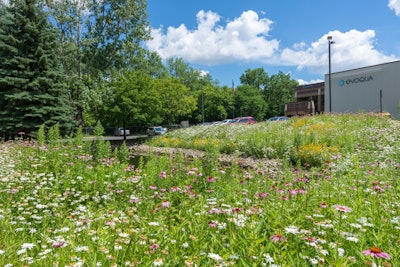 This hospital campus at Methodist Hospital features a healing garden and focused on water management.
This hospital campus at Methodist Hospital features a healing garden and focused on water management.Photo: Prescription Landscape
Prescription Landscape, based in St. Paul, Minnesota, was founded on a desire for healthy land management practices and since then it has been working to align its clients with environmentally sustainable standards.
The commercial landscape company says it is working to raise the environmental bar for its clients and believes it is landscaping companies’ responsibility to take the lead in this area.
“First and foremost, it is for the protection of the property and the people who frequent that property,” says Paulita LaPlante, managing partner and chief strategy officer for the company. “That is our primary mantra. If we are an advocate for people and property, then that means we engage in practices that will help the property owner to improve the health of the landscape and mitigate problems with the property.”
She says that bad landscape management practices can lead to a whole host of problems that are both stressful and costly to property managers.
Changing mindsets
Despite a general awareness of the importance of sustainable practices, LaPlante says it has been a challenge changing commercial customers’ minds. She says it can be difficult to get property managers to be willing to alter their methods when they’re focused on what is the most economical.
“I get it,” she says. “Everybody’s on a budget.”
To get property managers to see the value of sustainable practices, LaPlante starts with cost reduction through water audits. She says typically, clients either have a poor irrigation system or an irrigation system no one cares about.
“That’s where we usually gain the most traction,” she says. “If our sustainability starts with water, that is what drives our success in converting that client to sustainable practices each and every time. That’s always the heart of it.”
The water audit can save money in the first year for a client who is not using smart watering practices. Sometimes, it can be as simple as changing certain watering practices to overhauling the entire irrigation design, but the ROI is always there.
“You have to give them tangible, measurable savings that they will see in order to benefit from this,” LaPlante says.
From there, Prescription Landscape can move on to changing opinions about other aspects of property management.
“If you just get someone to focus on water usage outside the building, that’s meaningful,” LaPlante says. “The second element of water is water quality, and we can get people to focus on that in our snow season.”
In Minnesota, there is an issue with salt pollution, due to the tremendous amount of rock salt put down on roadways and properties during the winter. Prescription Landscape works to reduce the amount of salt it uses on commercial properties while still maintaining safety.
The company’s CEO/COO Ryan Foudray is particularly passionate about smart salting practices.
“In order to use less salt, you have to go to more expensive intervention,” LaPlante says. “So, we use brine, we use hand shovels, we use people that broom. But the problem with that is those things cost more money. And you have to be able to successfully find that labor pool to deliver those services.”
While it may be more costly, LaPlante believes these efforts are worth it in the long run.
She says that if no one challenges their commercial clients to have more sustainable landscapes, climate change will inevitably follow.
“It’s simple as that,” she says. “It really is. Our waters will be polluted with salt. We will waste water.”
All about education
Although it’s slow going right now changing property managers’ mindsets, LaPlante believes the next generation that will take on these roles in the future will be more open to adopting sustainable practices.
“That improved awareness is helping us to deliver a message that is actually heard,” LaPlante says. “Because you can say the same thing over and over again to someone who really is closed to that message. I am very hopeful about a new generation of property managers who are able to hear that message about sustainability and what it means.”
Additionally, Prescription Landscape takes it upon itself to help educate its customer base as well.
 Natural areas like this are not planted and then ignored. Urban care gardeners with Prescription Landscape hand pull invasive plants such as Canada thistle and Buckthorn.
Natural areas like this are not planted and then ignored. Urban care gardeners with Prescription Landscape hand pull invasive plants such as Canada thistle and Buckthorn.Photo: Prescription Landscape
“We have a series of handouts,” LaPlante says. “We have a series of presentations and we have professionals on our staff who can talk knowledgeably and educate convincingly and that is important.”
Even if it isn’t a renewing customer, Prescription Landscape’s account managers are tasked with providing educational opportunities. The company stresses that educating and being consistent about it is how they slowly change customers’ minds.
Prescription Landscape’s commitment to sustainability and spreading that message has not caused them to lose any clients.
“You have to meet people where they are in order to make a change,” LaPlante says.
When it comes to snow and ice management and customers who want an overabundance of salt applied, LaPlante says it comes down to educating those clients on what that behavior will lead to, including salt eating away at the concrete and being tracked inside the building.
“I believe our sales teams have done an excellent job of saying, ‘Here’s how much this costs, here’s what this is, here’s how we can save you money,’” LaPlante says. “And if you constantly come back to money, we usually can find a way to convince people. I’m not saying that what we’re doing is cheap. We have to look at ancillary costs associated with bad practices.”
In LaPlante’s opinion, an ideal sustainable landscape has several main elements, including native species, diversity of species and correct planting to maximize shade and water retention on a property.
“It’s best to keep as much water in place on the property with the correct soil structures, but also the correct types of plants,” LaPlante says. “Plants with deep roots, with fibrous roots, not just tap roots, and a diversity of trees on the property, not just a single type of tree.”
Another area of untapped potential for commercial clients is the installation of rooftop gardens, which are not only a beautiful amenity but also provide cost savings and a place for pollinators, depending on the height of the building.





